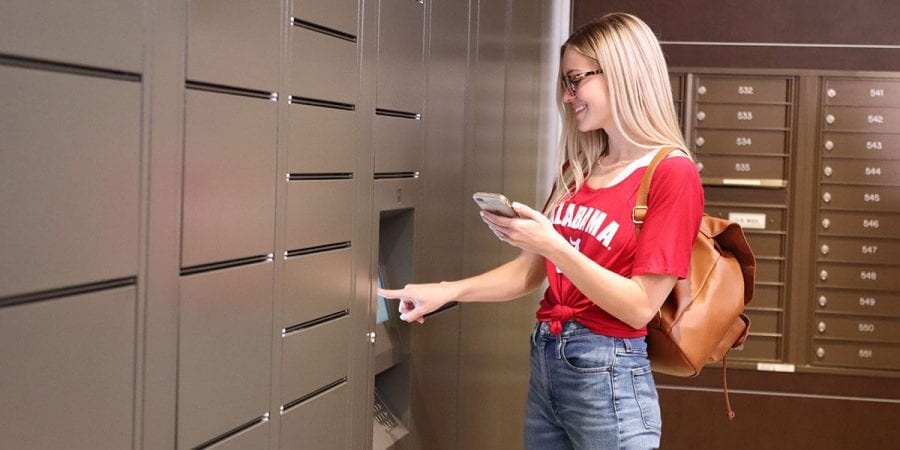
University
How to Secure Funding for Your Campus Food Pantry
Written by: Parcel Pending
5 Min Read
Published: November 4, 2025
Updated: November 3, 2025
Financial contributions are the lifeblood of every food pantry. While food donations help meet immediate needs, grants and corporate contributions provide the stable foundation that sustains successful programs. This is because food pantries require ongoing funding for operating expenses, facility costs, salaries, program development, and technology investment. In fact, monetary contributions account for 66% of food pantry funding nationwide.1
This blog explores practical strategies for securing financial support for on-campus food pantries, including how Parcel Pending by Quadient can help with securing funding for food locker-based initiatives.
The Alarming State of Student Food Insecurity
Food insecurity has reached crisis levels. According to Feeding America, 50 million people rely upon food banks every year. The statistics on college campuses paint a similar picture. At four-year institutions, 38% of students face food insecurity, while rates climb even higher at community colleges (48%) and two-year schools (44%).2 Further, a recent Inside Higher Ed survey found that 41% of students experienced food insecurity within just the past month, with fewer than half (44%) reporting consistent access to adequate food.3
Why aren’t students seeking help? The barriers are heartbreaking: 30% believe other students need the food more than they do, while 21% feel embarrassed about using pantry services. This stigma means students are choosing hunger over assistance.
Identify Funding Sources
In order to establish or gain further funding for a campus food pantry, identifying funding sources is essential. Although there’s no central clearinghouse noting the availability of funds for food pantries in higher education, there are key state, local, and federal agencies from which to begin your search. Here are a few good starting points in your search:
-
- USDA Food and Nutrition Service – These USDA funds support organizations offering nutritional assistance, including meal distribution centers.
- USDA National Institute of Food & Agriculture – NIFA publishes an RFA (Request for Applications) calendar at the start of each fiscal year listing all available funding opportunities.
- Community Food Projects – CFP provides one-time infusions of federal funds between $125,000 and $400,000 (over four years) following 1:1 matching and a program assessment.
- Feeding America – This organization provides various funding opportunities tailored for food pantries that address specific needs.
- Swipe Out Hunger –This organization partners with colleges to alleviate student hunger by donating dining hall swipes and helping campuses build and fund basic needs programs.
- Corporate Giving Programs – Large, local companies often prioritize philanthropic initiatives that support nutritional security.
- State and Local Government Grants – Consult your state’s department of health or agriculture for accessible funding. Roughly a dozen states have already passed “Hunger Free Campus” legislation, which sends funding to public colleges addressing student hunger on campus. Several others are also considering the legislation.
Note: if you are interested in adding smart lockers as part of your campus food pantry, you may qualify for grants targeting service expansion tools, equipment upgrades, or other technology investments.
Build a Budget
Once you’ve identified your funding opportunities and any associated requirements, develop a comprehensive budget that clearly demonstrates how funding will be used. Your budget should align directly with the objectives in your application, showcasing both fiscal responsibility and strategic planning. Be transparent and specific. Grantmakers expect a detailed line-item budget that accounts for every dollar, from operating costs to equipment purchases.
Grantmakers today are also looking for a sustainability plan that outlines how the pantry will continue operating after grant funding ends. This demonstrates to funders that their investment creates lasting impact rather than temporary relief and positions your program to attract additional philanthropic support.
If your proposal includes smart lockers for food distribution, consider obtaining detailed quotes from vetted vendors to include with your application.
Create an Application That Stands Out
A good application hinges on providing document that show a strong need for support. It must address your community’s hunger challenges, the current need, the pantry’s mission, and outline a future strategy. Goals and objectives are also key. Grant readers want to understand how the financial contribution will achieve the specific goals. Build a roadmap of how the capital infusion will meet the objectives, including staffing needs, corporate contributions, and leadership.
Follow Up Regularly
Regularly following up demonstrates your commitment to the cause and keeps you informed about the status of your application. Reaching out on LinkedIn and other social media platforms is a great way to build connections. Networking within your community is also a great way to foster relationships.
Delivering MORE Support for Your Campus Food Pantry
Smart lockers transform food distribution from a potentially embarrassing experience into a discreet service that students can access on their schedule. For instance, the DISH (Deliver Information, Sustenance, and Health) initiative at Bunker Hill Community College demonstrates the transformative power of this approach; DISH selected Parcel Pending by Quadient as its locker partner for its food pantries. In the 2024 academic year alone, DISH distributed more than 95,000 pounds of food and facilitated 1,400 locker pickups.
As Rob Zinsky, Vice President of Business Development, explains: “Individuals obviously are sensitive about going into the food pantry, so the ability to order a meal online and pick it up discreetly in a locker anytime they want can be game-changing.”
How Parcel Pending Supports Your Grant Success
Parcel Pending by Quadient has pioneered an approach that addresses campus food insecurity while preserving student dignity. If you’re ready to implement smart lockers as part of your campus food pantry solution, we can provide support for you and your team throughout the grant-writing process:
MORE Options
We can provide customized quotes and configuration mock-ups tailored to your campus needs and space constraints. Plus, we offer special discounts for Swipe Out Hunger member campuses, making locker solutions more accessible.
MORE Results
Strengthen your grant application with compelling case studies and data points from institutions we support nationwide. We’ll help you demonstrate proven ROI and student impact to potential funders.
MORE Support
Our team partners with you from application through implementation and beyond. We’ll help you craft persuasive grant narratives, provide technical specifications, and ensure seamless installation. After launch, our ongoing support ensures that your students, staff, and faculty receive the help they need without interruption.
With a growing number of students reporting struggles with food insecurity and consistent access to healthy food, we’re not just facing a hunger problem, we’re facing an access and dignity problem. Smart lockers not only help your institution distribute food more efficiently but also fundamentally reimagine how you support struggling students without stigma.
Ready to lock in a smart locker solution for your campus food pantry? Contact a Parcel Pending by Quadient representative for support with getting lockers in your budget.
Sources:
- Olean Food Pantry. Why Local Nonprofit Food Pantries Need Grants to Fight the War on Hunger. oleanfoodpantry.com. n.d. https://oleanfoodpantry.org/why-local-nonprofit-food-pantries-need-grants-to-fight-the-war-on-hunger/
- Landry, Matthew J. & Eicher-Miller, Heather. Pandemic threatens food security for many college students. theconversation.com. October 9, 2020. https://theconversation.com/pandemic-threatens-food-security-for-many-college-students-146823
- Mowreader, Ashley. Survey: 3 in 5 College Students Experience Food or Housing Insecurity. www.insidehighered.com. February 27, 2025. https://www.insidehighered.com/news/student-success/health-wellness/2025/02/27/most-college-students-lack-sufficient-food-housing



